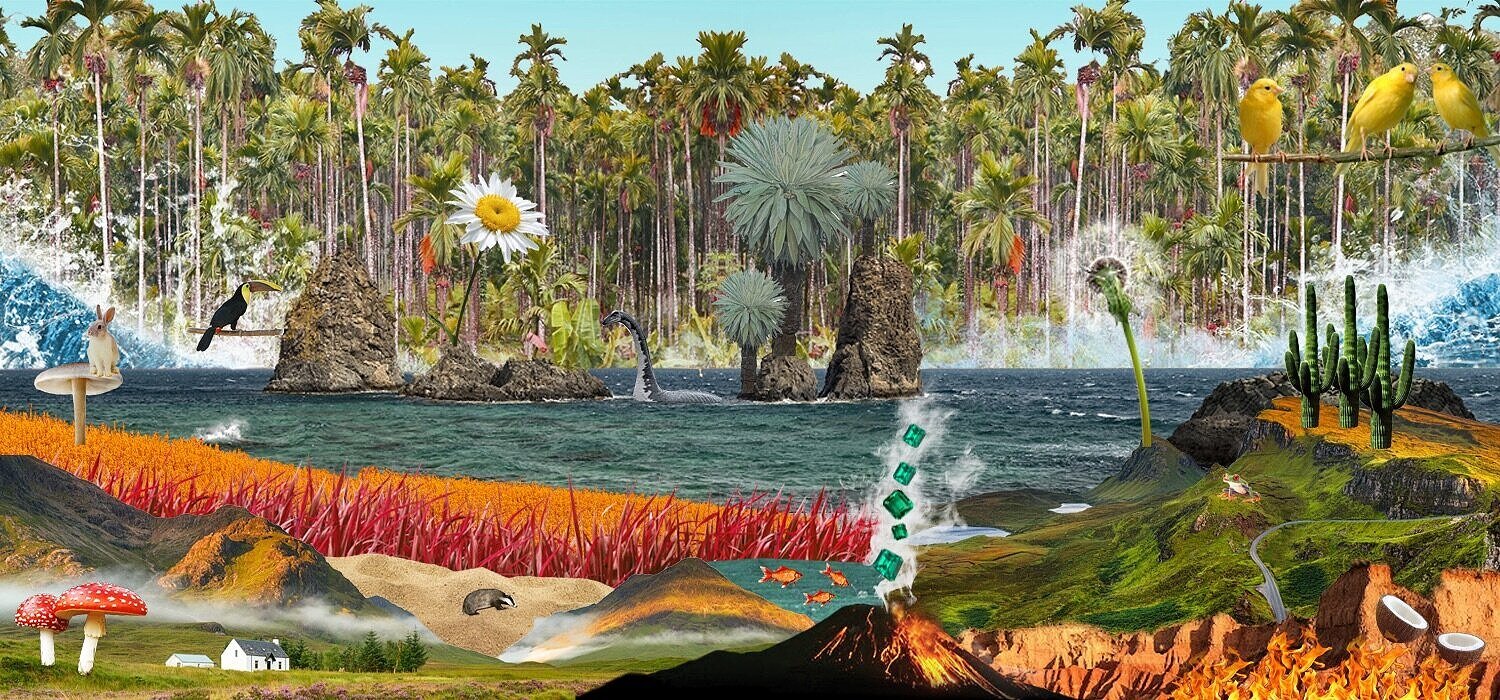

DAY 2
How can we honour the natural environment through creative processes?
Venuz White
Director & Editor: Sara García - Creative Director: Venuz White - Sound production: Manuel Suarez - Voice: Maimará
Water Revelation:
Argentina
Venuz White finds inspiration in ancestral practices and technologies to visually present the "Voices of Water” manifested through colour pigments, water and voice vibrations. As a result of a digital artist-in-residence programme at ÚNA, the Colombian artist will unveil for the first time ever her "Water Revelations", a series of contemporary rituals bringing together five female voices from Brazil, Scotland, Chile, Mexico and Argentina.
This is the Water Revelation from Argentina, represented by the singer, composer and poet Maia Priscila Marazzo, better known as, Maimará.







Wilson Rodríguez
Wilson Rodríguez’ work is an extension of his father Abel’s botanical knowledge of the Amazonian jungle. The artist’s practice is distinguished, however, by its embrace of elements beyond the medicinal and practical uses of plants—that being the relationship between humans and the “invisible world” or, more specifically, the use of plants as a means of expanding perception and forging connections with the ancestral world. For Wilson, who has been receiving ancestral knowledge all his life, art is a way to hone this plant knowledge while living in Colombia’s largest city of Bogotá.
Special thanks to Instituto de Visión

INDIGENOUS ELECTRONIC ART
Digital Painting in Karapotó / Pintura Digital em Karapotó
An extension of the concept of body painting using technology that opens the door to new experiences and new conversations. Participants drew the elements present in their natural environment which were then animated and projected onto their bodies. Bruno Gomes Residency with the Karapotó Plak-ô community, municipality of São Sebastião, Alagoas, 7-18 June 2018.
©Thywêdá | 2018 | Karapotó Plak-ô, Brazil | 2 min
Film curated by: Native Spirit Foundation
They Are Listening:
Reflections with Kariri-Xocó
Film curation: Native Spirit Foundation
Nicolas Salazar Sutil’s residency with Kariri-Xocó focused on the river Opara (São Francisco) one of the main sources of sustenance, memory and culture of the community in Brazil. Three site specific performances explored stillness, posture, and the use of space to symbolise land reclamation, resilience, and rootedness. The ‘they’ of the title refers to the river spirits of the Opara which has been drying up over the years as a result of agricultural exploitation upstream. For Kariri-Xocó and other Indigenous and traditional communities that live in, on, and with the river, this is an existential threat to lifeways and culture. The river spirits are listening in expectation of a dialogue with those few communities who still understand their symbiotic relationship with the river, and who can speak up to save it. Songs in Kariri-Xocó and Yathé.
©Thywêdá | 2018 | Kariri-Xocó, Brazil | 8 min


Sekai Machache
Sekai Machache is a visual artist and curator based in Scotland, whose multidisciplinary work is a deep interrogation of the notion of self. She is interested in the relationship between spirituality, imagination and the role of the artist in disseminating symbolic imagery to provide a space for healing. Born in Zimbabwe and raised in Scotland, she has a particular interest in W.E.B. Dubois’ notion of Double Consciousness: the psychological challenge of having African heritage while living in the West. In addition to working collaboratively, for and with her community, Machache works internationally, with her most recent project taking her to Brazil.

Maimará
For many years, Maia Priscila Marazzo, or better known as Maimará, has dedicated herself to ancestral song, through which she explores the Andean worldview and the role of women as carriers of wisdom. Critiquing musical archetypes and aesthetic stereotypes, Maimará searches for the original voice that connects us with the ancestral and with the cosmovisions of Indigenous peoples. The artist focuses specifically on promoting and reclaiming the role of the copleras -women who sing- who narrate thoughts and lamentations, daily chores and festivities, who redefine ancestral knowledge and spoken tradition from the Andean settlements.


Nación Ekeko
Nación Ekeko is the solo-project of Argentinian musician and producer Diego Pérez. His sound merges modern electronic music with the deepest musical roots of Latin America, creating truly unique and enchanting melodies and rhythms. Nación Ekeko promotes a message of connectivity and community by including sounds from many different heritages. Through the integration of different concepts and ideas, Diego’s goal is to musically erase the arbitrary borders that separate different cultures. Within Nación Ekeko various ideas converge: learning about community living, experimenting with electronic elements, connecting to music with one’s body while also conveying a meaning and a message.

Toxcatl
Film curation: Native Spirit Foundation
Director Joana Lirio. Dancers Eduardo S J, Adan Garcia, Jessica Si | Mexico | 2020 | 3 min Toxcatl is a celebration at the heart of Mexicah culture that happens between the 5th and 25th of May. People celebrate the end of the dry season and beginning of the raining season. They offer dances and songs to remind us that without water there is no life.
In 1520 Spaniards ambushed The Festival of Toxcatl at The Templo Mayor, Tenochtitlan (The City of Dreams) in present day Mexico City. Exits were blocked at The Gate of the Eagle, The Gate of the Canestalk and The Gate of the Snake of Mirrors. The ensuing massacre at The Patio of the Gods included Mexicah Warriors, Nobles, Leaders and Tlamacazui (priests). But the Mexicah people retaliated and victoriously expelled the invaders.
The Toxcatl Massacre is remembered as La Noche Triste (Sad Night) for the Spanish Latinos. Mexicah people call it Yohualltepanahualiztli (the Victorious Night). Named after the fifth month, or veintena, of the Aztec ritual calendar xiuhpohualli, this festival was historically held annually in many Aztec cities, and is dedicated to warrior gods Tezcatlipoca and Huitzilopochtli. Reference: Fray Bernardino de Sahagún, Florentine Codex, Book 12, Chapter 20 (Mexicah)


Do you have any questions or for any of our artists?
Stay tuned on our social media channels for the upcoming ÚNA Podcasts where artists, musicians, filmmakers and artivists will speak about arts, ecology and sustainability. What would you like to know? Share it below!
